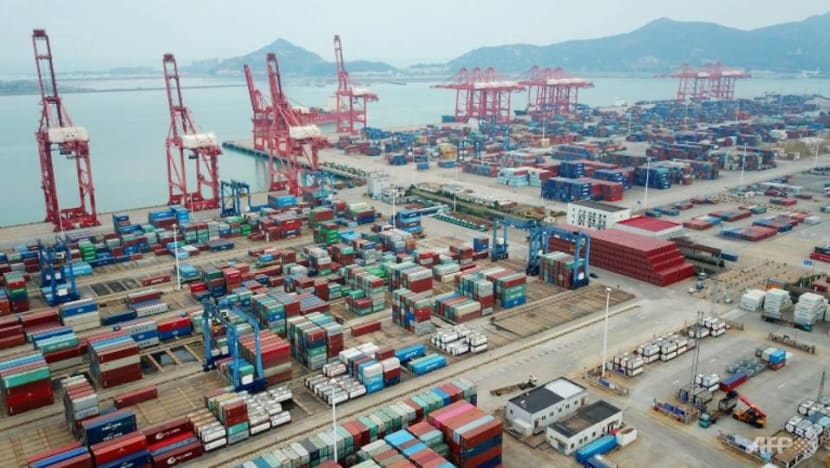commentary Commentary
Commentary: China’s divide-and-conquer strategy isn’t fooling anyone anymore
Recent actions involving Australia and New Zealand reveal the country’s modus operandi can be effective but will have broader, corrosive implications for China, says Christian Le Miere.

The Chinese national flag is seen in Beijing, China on Apr 29, 2020. (Photo: REUTERS/Thomas Peter)
LONDON: Exactly 500 years ago, the Italian Renaissance philosopher, Niccolo Machiavelli, published his treatise, The Art of War.
In it, the chief protagonist, Lord Fabrizio Colonna, declared: “A Captain ought, among all the other actions of his, endeavour with every art to divide the forces of the enemy.”
Half a millennium later, this principle seems to describe one of China’s foreign policy dictums.
Case in point? Australia. The country has come under the Chinese radar in recent months.
Import bans, tariffs and other restrictions on Australian wines, beef, barley and more were slapped on after April 2020, when Australia led calls for international inquiries into the origins of the coronavirus, apparently without consulting China beforehand.

A second round of curbs were rolled out in early November, with live lobster, timber and more delayed at the borders, though formal notices on bans were not issued.
READ: Commentary: Can China produce grape wine as fine as the French?
A SPAT BETWEEN NEW ZEALAND AND AUSTRALIA
But punitive sanctions on Australia are only part of the divide-and-conquer story.
Here’s exhibit B: China signed a trade deal with New Zealand in January to upgrade an existing free trade agreement, removing or cutting tariffs on many of the very same goods Beijing just sanctioned from Australia.
The overall messaging is clear: Anger Beijing and we will punish you. But stay on Beijing’s good side and we will reward you.
READ: Commentary: Taiwan is becoming the biggest test in US-China relations
And the strategy is effective. It’s challenging for countries benefiting from greater access to the world’s second-largest economy to give up that reward.
That same month, Australia and New Zealand had an extremely rare diplomatic spat recently.
New Zealand Trade Minister Damien O’Connor suggested Australia should “show respect, and speak with a little more diplomacy” to China when asked by CNBC about the timing of New Zealand’s trade deal with China and what role New Zealand could play in mediating in the dispute.
It was a remarkable statement that underlined the growing tensions in the usually rock solid trans-Tasman relationship.

A PATTERN OF COERCIVE DIPLOMACY
Beijing uses a range of tools and tactics to divide and conquer. This consists of economic and diplomatic levers to punish states that have transgressed unwritten red lines and market-based enticements for smaller, weaker states to cultivate influence.
Many such tactics are not unique to China. It is commonplace for countries, particularly larger ones, to sanction others in tits-for-tats to shape behaviour and maintain state-to-state relations on an even keel in protecting domestic interests and pursuing national goals.
But Beijing is relatively unusual in the manner in which it undertakes this coercion, using disproportionality, extra-legal processes, and deniability.
Through obfuscation and manipulation, it wants to condition countries to consider China’s interests.
READ: Commentary: Trump’s playbook on China in the South China Sea has some lessons for the Biden administration
In the Australia case, for example, technocratic reasons for the sanctions rather than government policy were given by China, from alleged mislabelling of wine to delayed quarantine inspections and claims of beetle infestations in timber.
China’s track record on this has been consistent. The awarding of the Nobel Peace Prize to a Chinese dissident led to an unofficial ban on Norwegian salmon exports in 2013.
The arrest of a Chinese fishing trawler captain by Japan saw an unofficial export quota on rare earth metals in 2010.
READ: Commentary: After a stormy few years, verdict on Trump’s trade war with China is clear
Mongolia too saw an increased in import taxes followed a 2016 visit by the Dalai Lama. The Chinese Foreign Ministry even went as far to say: “We hope Mongolia has taken this lesson to heart.”
In all these infractions, China punishes each nation disproportionately in a bid to deter similar actions, while simultaneously using unofficial avenues to avoid being labelled as a bully.
Worryingly, the use of such coercive diplomacy has been expanding rapidly in recent years: A report by the Australian Strategic Policy Institute in September 2020 tabulated more than 150 instances of Chinese economic coercion between 2010 and 2020.
From 2010 to 2017, the number of cases of such coercion never rose above 20 each year; by 2019, it was nearly 60.
READ: Commentary: Major countries are concerned about implications of China's rise. So is China
GLOBAL PUSHBACK
This growing use of coercion is a key part of China’s divide-and-conquer strategy, alongside incentives and diplomatic attempts to drive wedges in multilateral grouping.

The strategy has served China well in recent decades, especially in this region. As an example, China’s insistence on bilateral negotiations and general foot-dragging has hampered progress on a binding Code of Conduct in the South China Sea with the ASEAN states, some 20 years since the non-binding Declaration of Conduct was signed in 2002.
But there are now signs this strategy is beginning to fail. China’s more assertive foreign policy has managed to unnerve a range of regional states, whether from clashes on the Sino-Indian border, coast guard and maritime militia activity in the South and East China Seas, or flights through the air defence identification zones of neighbouring states and entities.
READ: Commentary: They already have jet bombers and super missiles. Will Chinese fighter jets be more powerful than America’s soon?
These activities are encouraging a more united stance among regional states, with a broad pushback against China now being facilitated by a more engaged US.
With a strong bipartisan consensus in the US for a more hawkish policy towards China and a new administration, the US is adopting a traditional leadership role in this key strategic area.
In doing so, the US is bringing together allies that might otherwise be looking to compete with each other for China’s favour.
China is thus watching with dismay as the Quadrilateral Security Initiative (the Quad) develops rapidly into an anti-China proto-alliance, while four of the Five Eyes (the US, Canada, Australia, and the UK) engage in activities that irk China, from arresting Huawei executives to offering Hong Kongers passports.
China’s divide-and-conquer strategy could be counterproductive, as states grow conscious of such tactics and cooperate with each other to hedge against China across various fields of engagement – trade, regulation, defence and security.
READ: Commentary: To its own detriment, the US still doesn’t understand China
The consequences for Beijing are serious.
A more hostile international environment, with rival states coalescing into alliances and groupings designed to thwart China’s ambitions of becoming a global superpower and achieve sustainable growth could arise.
That would be unfortunate indeed not just for the world but for China, if such a divide-and-conquer strategy creates a more bifurcated and antagonistic international order inimical to China’s rise.
Christian Le Miere is a foreign policy adviser and the founder and manging director of Arcipel, a strategic advisory firm based in London.















